Photographed just north of Garcia Pass 13th Sept. 2011.
Look at the beautiful colour of the fruits. Most of the plants is underground.
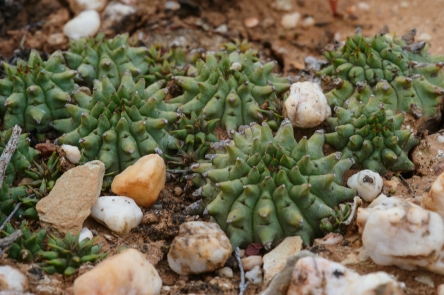
When I first saw these little beauties on a hillside on the outskirts of Calitzdorp I had no idea what they could be, but after some searching in my library I found the original description of the species by Ernst van Jaarsveld in Bradleya 1994. Although it has since been found in a few other places and is now known to occur from Calitzdorp in the west to De Rust in the east it is considered critically rare. It grows in the shade of shrubs and often forms dense clumps. The photograph was taken in the first week of May last year.
Succulent organs filled with water are quite heavy. In miniature succulents most of the body weight is near the ground, so that there is little or no need to build and maintain a strong support system. Because they are so compact, they are also far less exposed to external influences than other plants.
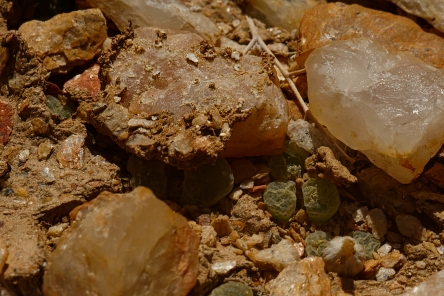
Plants like this Conophytum praesectum from near Pofadder are small enough to benefit from shade cast by pebbles
The fact that a great part of the plant is near to the soil has another -and rather unexpected- advantage. In the areas where succulents grow, wind is usually present and is often hot and strong. The continuous replacement of air around the plants has a dehydrating effect, so that evaporation can be extreme. Apart from this, the wind transports sand and dust, causing sand abrasion, which may damage the plants (especially seedlings) and remove hairs or wax cover.
Because of surface roughness, wind speed is zero at ground level, and wind becomes stronger with increasing height above the ground. It follows that the lower the plant, the less likely it will be to suffer from wind damage.
A drawback of being small is that smaller leaves and stems have a larger surface-area-to-volume ratio than large ones. As a result, their transpiration is relatively higher and they are more prone to heat stress. The fact that dwarf succulents have more or less spherical leaves or stems, helps to alleviate the problem. With regard to minimising evaporation, a sphere is the ideal shape, as it combines the minimum surface area with the maximum internal volume. (The surface area of a flat leaf is about 40 times bigger than that of a perfect globe with the same contents).
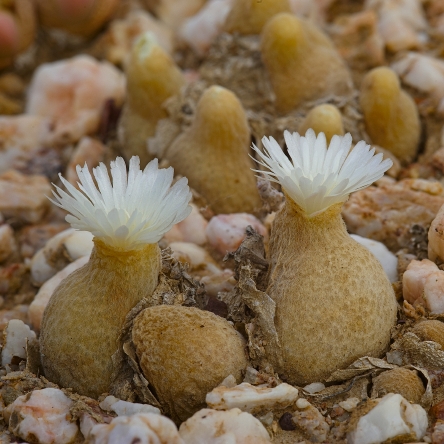
In the rare Muiria hortenseae from the southern Little Karoo, the two leaves making up each body are fused almost completely, so that the flowers have to force their way out
In some cases, pairs of leaves have grown into one, so that each pair resembles a little globe. Densely packed leaves or stems can attain similar results.
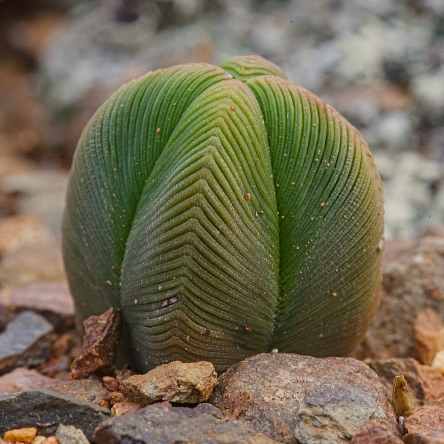
In Crassula pyramidalis the leaves fit so densely together, that it first sight the plant looks like a stem succulent rather than a leaf succulent
Water loss from the surface of the plant can further be minimised by (the plant) hiding underground. In dry periods, the plants are often completely hidden in the soil, covered with the sand and dust blown over them. Only when the bodies fill out at the beginning of the rainy period do they appear above ground again.
Experiments have shown that in Lithops the rate of water loss is about a fifth lower in plants that are embedded in the soil than in those totally exposed.
In addition, the daily variation of temperature in the leaves is reduced. This is important during the hottest part of the day, when the parts of the plant that are furthest away from the soil surface, stay cooler than those nearer the ground.
Hiding underground also has its disadvantages. Because less surface area is available, photosynthesis is much reduced, so growth is slowed down.
The famous window plants have found a way to reduce this problem. These plants occur almost exclusively in the dry winter rainfall areas of southern Africa and are found in just a few families- most commonly the vygies (Aizoaceae, several genera). Other examples are Haworthia and Bulbine.

Haworthia truncata has a limited distribution area around Calitzdorp and Oudtshoorn. It is one of a number of Haworthias with windows
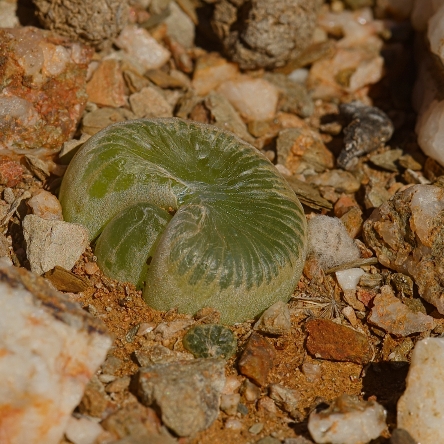
A perfect specimen of waterglasie (Bulbine mesembryanthoides)
The classic example is Fenestraria rhopalophylla: The plants are practically stem less and have club-shaped leaves with a translucent area on top.
As only a small part of the leaves is exposed to light, photosynthesis would normally be seriously hampered. The window at the top however, combined with translucent water-storage cells deeper inside the leaf, makes it possible for light to penetrate into the leaf and reach the inside of its mantle. Here, (there) are cells that contain chlorophyll and make photosynthesis possible.
The plants grow in the mist zone on the coast of northern South Africa and southern Namibia where the leaves are drawn into the ground by thick contractile roots. Usually the plants grow in deep sand, but sometimes they are found in pockets above dolomite rocks. Although the plants are only a few centimeters across, the root system may cover up to 2 metres. The mat of fine roots just underneath the surface is able to absorb the condensation of the moisture brought in by the sea fog, which is the main source of water for these plants.
The leaves are usually flush with the sand so that they do not suffer from the strong winds that blow almost daily.
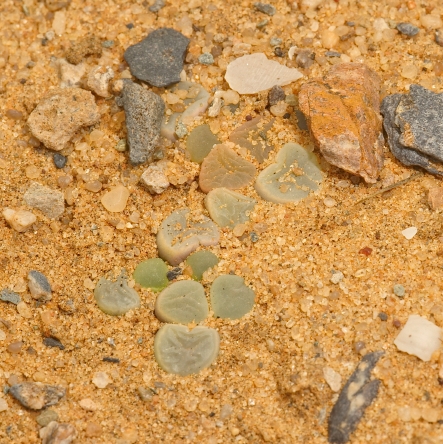
This F. rhopalophylla ssp. aurantiaca was photographed south of Port Nolloth, in close proximity to the sea
The so-called stone plants – among the smallest flowering plants in the world- have followed a slightly different route. They have very thick leaves, often with dark green dots in their leaf tops. These dots contain no pigment and may be either large single cells or a group of smaller ones. They lie just below the epidermis and serve as micro windows, which may take up to over 40% of the leaf surface. In winter, when the sunlight is weak, the non-pigmented zones help it to penetrate into the leaves.
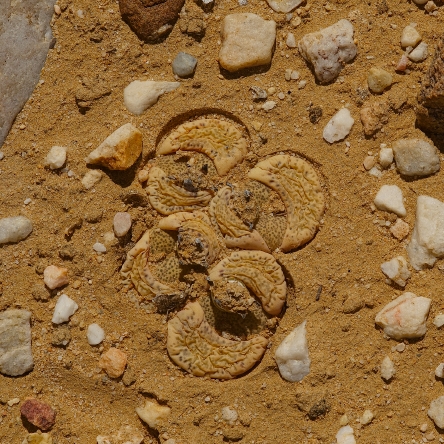
Lithops localis near Prince Albert, showing its many micro windows
A peculiar adaptation is shown by many members of the mesemb family (Aizoaceae), especially the dwarf ones, which are able to recycle water from old leaves to new ones.
This phenomenon was already discussed in an earlier post (Water recycling in succulents, 4th Dec. 2012), so please have a look there if you are interested.
In this article, I have tried to highlight some of the intriguing adaptations miniature succulents deploy in order to survive. Of course, these are only a few of the techniques and strategies they have in common with other succulents. But that is another story, for another day.
***
The original version of this article appeared in the most recent issue of Veld & Flora (March 2013). If you are interested in the immensely rich flora of South Africa, it is well worth visiting their website: www.botanicalsociety.org.za.
***
Since I wrote the article I acquired a new piece of software (Inspiration) which allows the user to make mind maps, concept maps, flow charts etc. in a very intuitive and easy way. I had tried out similar programs before, but never liked the results, nor the way they worked. To my mind, this program scores well on both points.
As I am currently working on a book on how succulents survive in the wild, I thought it might be helpful to use a diagram such as the one below, to make complicated processes and relations a bit clearer.
It would be great if readers would have a critical look at this diagram and tell me if it works for them. Many thanks in advance!
A few months ago I mentioned an article that I had written for “Veld & Flora” . Now that this has been published, I will share it with you here in a slightly modified version.
***
Succulent plants come in all shapes and sizes. Some of them, like baobabs and certain cacti, are enormous, able to store great quantities of water. At the other end of the scale, we find the results of a trend towards reduction that can be seen in several unrelated families such as Aizoaceae, Asphodelaceae, Asteraceae, Crassulaceae, Euphorbiaceae and Portulacaceae. These miniature succulents are both small and compact, not taller than a few centimeters, often little branched, without visible internodes and with more or less spherical leaves or stem(s). (In case you don’t know: an internode is the part of a stem between the points where leaves or branches develop).
Sometimes the trend involves neoteny. This is a situation in which plants or animals retain juvenile or embryonic characteristics throughout their life span, but nevertheless are able to reproduce. (A famous case in the animal kingdom is the Mexican axolotl).
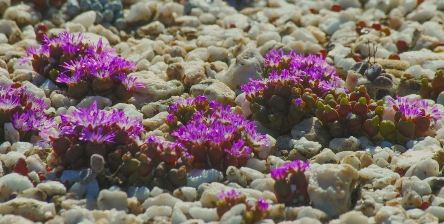
An interesting example in plants is the genus Oophytum, which only occurs on the Knersvlakte. It is a member of the Mitrophyllum group that only produces juvenile leaves. In effect, they are therefore perpetual seedlings.
Among succulent plant enthusiasts, miniatures are long-time favorites. This is hardly surprising, because even a small space can harbour a nice collection of them. There’s also an amazing abundance of shapes and colours, so that even without flowers there is always something to marvel over.
Last but not least, there’s great variety in their survival needs. In other words, both beginners and advanced growers will be able to find plants that fit their knowledge and ability. To grow some of these plants from seed to maturity is quite a feat, whereas others are much more amenable.
Even if you are not interested in keeping plants in captivity, there are many reasons for having a closer look at these dwarfs. In this article, we will focus on the way they cope with the challenges of their environment and make use of its opportunities.
Being small has both advantages and disadvantages, some of them evident, others much less so. Often the situation is rather complex. The solution for a problem may create a new problem, which in some cases is then (partly) remedied by another solution. Trying to understand this balancing act is an interesting exercise.
The accompanying pictures will hopefully convince you that these plants are not just interesting; they are also beautiful and visually stimulating.
The most obvious advantage of being small is that you need only little water, food and space to thrive. (Of course, the opposite is also true: when there is an abundance of these necessities, small succulents cannot compete with faster growing plants).
Because dwarf succulents can store only small amounts of water at a time, their storage organs have to be refilled at regular intervals, so the supply should be dependable. For that reason, the great majority of them occur in the Succulent Karoo, especially in Namaqualand with its predictable winter rainfall supplemented by even more reliable fog and dew.
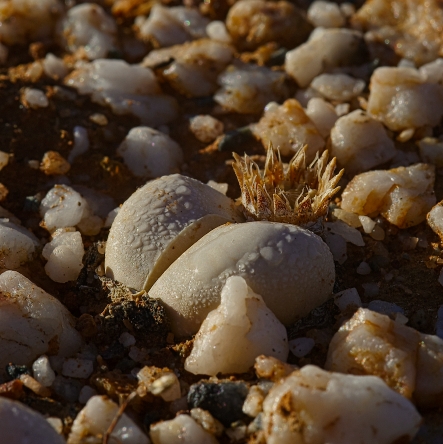
The hygroscopic fruit of this Argyroderma delaetii is still open early in the morning, as a result of the heavy nightly dew
The Succulent Karoo is not the only winter-rainfall desert in the world. Others are the southern Atacama Desert in Chile, the northwestern part of Baja California and the southern coast of Morocco. The first two especially, support a lot of succulents, but few if any of these are miniatures. In that sense, one could say that these little gems are a Southern African “invention”
The Succulent Karoo contains the richest concentration of succulents in the world. Whereas only about 140 species of stem succulents grow here, there are about 1700 species of leaf succulents, about 700 of which are small and compact. During the growing season, which is not just moist but also cool, these miniatures profit from the warmth of the soil.
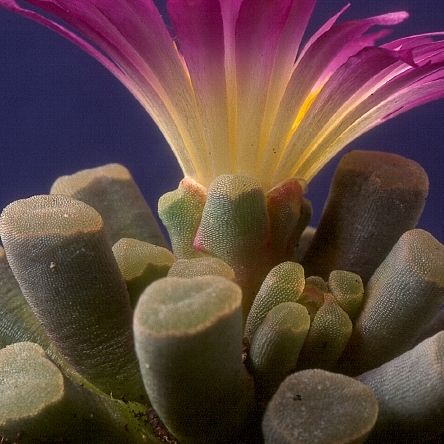
One of the few miniature succulents occurring outside the Succulent Karoo is this beautiful Frithia pulchra from Gauteng
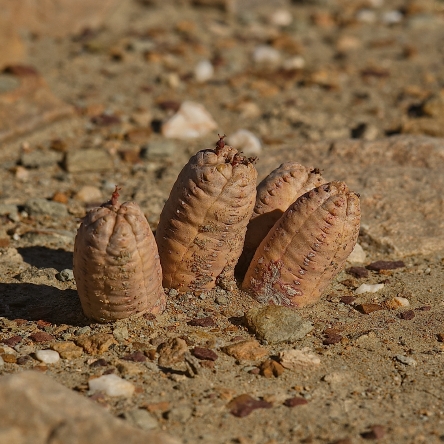
Not many stem succulents qualify as a miniature, but this Euphorbia pseudoglobosa from the Little Karoo certainly does
Small succulents are often restricted to places where water easily runs off, like gravel plains and quartz fields. Between and under rocks and stones, rainwater is often collected, providing moisture for small plants. In addition, dew and mist condenses on rocks and the moisture accumulates at their bases and in crevices. (Apart from water, this kind of habitat often also provides shade and protection from predators).
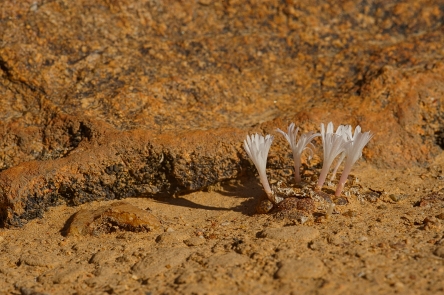
This Conophytum pellucidum, photographed near Kamieskroon, looks quite happy with the little bit of extra water that collects at the foot of a rock slab
To be continued.